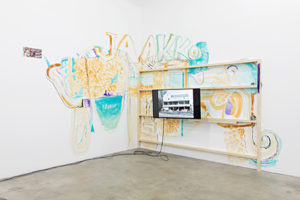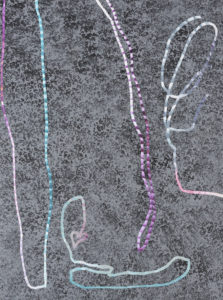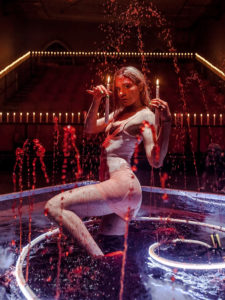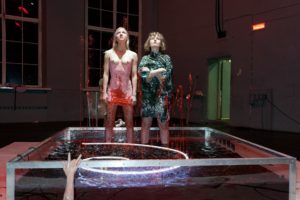“I guess it will be a kind of a celebration mixtape,” writes Maria Metsalu via email about her upcoming performance at London’s Kunstraum on November 25. With almost no video documentation of her live works online, and no press release, the Estonian artist, performer, musician and choreographer lists the three shows she’ll be sampling in her untitled show, including ‘Mademoiselle x,’ ‘Fuchsia‘ and ‘Life and Death of Maria Balkana,’ while “perhaps throwing in something fresh.”
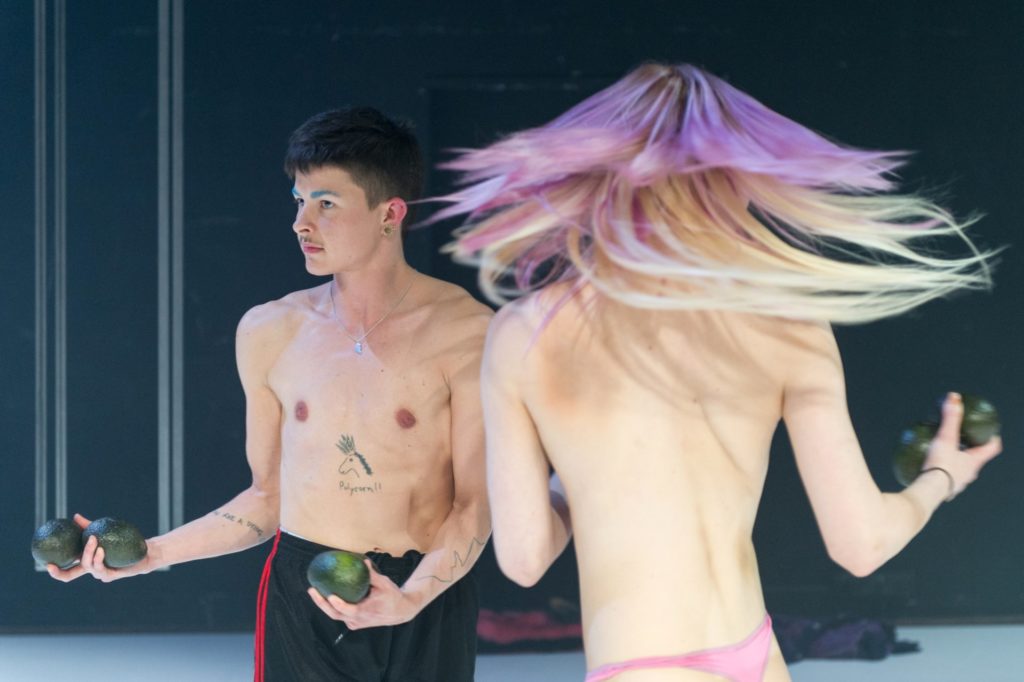
Metsalu will be performing as part of Merike Estna‘s fragments from the shattered toe solo exhibition at Kunstraum, running September 29 to November 25, which features a series of performances throughout the duration, taking place against the backdrop of floor paintings and and a painted stage. Metsalu, who co-founded Young Boy Dancing Group (YBDG), works both collaboratively and individually, with recent projects mutating into a form of collective practice where she facilitates and invites other artists to collaborate through set, music, costumes, which in turn synthesizes into her own work. This curatorial approach is about “creating some sort of a system and then trying to understand the relations between different components.”
“I am also thinking about the notions of opening and closing, in the sense that how a closing can be a beginning or birth of something new, rather than something finished or dying,” hints Metsalu about the upcoming performance. The currently nomadic artist, who comes from a background in choreography and body movement, talks to us about her cross-genre practice and what binds it all together.
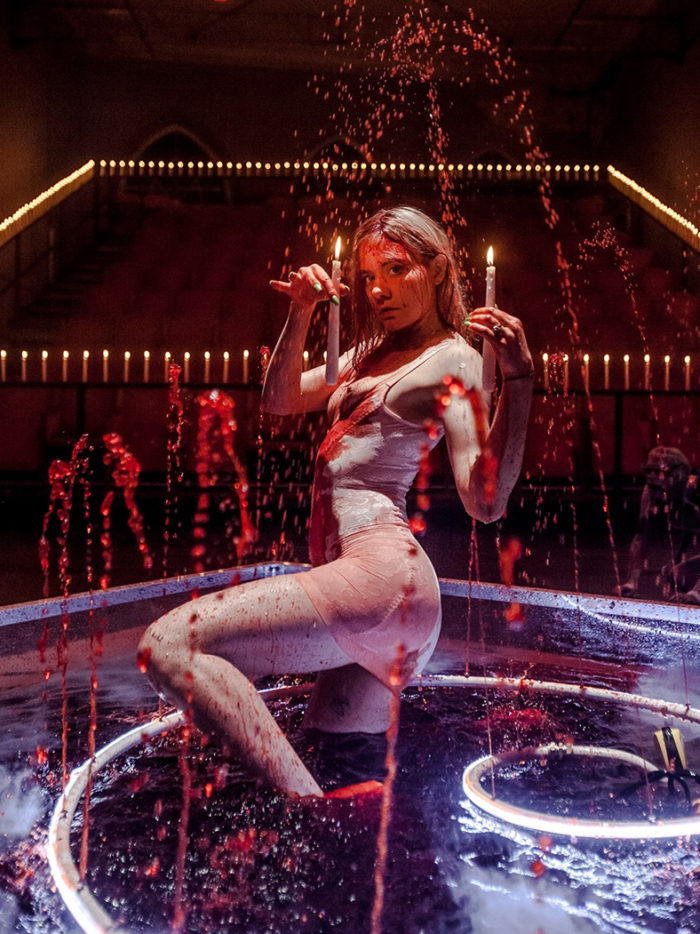
**I cant find any of your performances online, although your online presence through your videos and other platforms is very present — is this deliberate, to keep the live component of your practice sacred to that medium and space?
Maria Metsalu: I try to keep this kind of plain documentation separate from what is seen and experienced in a live show, as they are mainly meant for curators and all that. It is different when I am consciously making video work or throwing something out on Instagram. Perhaps I wouldn’t use the word ‘sacred,’ but the word ‘reasonable’ instead. I’m not interested in how much quantitative work I have online, to be honest, nowadays I try to keep that to the minimum necessary. Both for the sake that people can experience the live show knowing as little as possible and because my shows often contain elements and scenes that might be quite graphic and sexual. I am on the one hand pretty easy with these things but at the same time very selective with it.
**What are the various different spaces/contexts you perform in, online and off, and how do the works change depending on this and the audience?
MM: I think the most clear and obvious distinction is between the theater space and a gallery, because I perform a lot in both. These places are rather different. This not only concerns the audience that will come to these spaces in the first place, but also how they behave and how much time and attention I will have been given by them.
In the gallery setting people are more prone to invest in interactions at some level — they come closer — but at the same time, depending of the show of course, won’t always stay until the end. The online space is a completely different world, with its own unwritten rules.

Some years ago we had an interesting experience during a show in Amsterdam with YBDG. In the show, we had a scene in the beginning where me and two other girls were doing a camshow backstage on CAM4, so we had an online audience to whom we were performing. During the performance we travelled with the computer onto the stage, so that the people on CAM4 could also see the show, but all of them disconnected quite quickly. I guess we were breaking those online rules concerning intimacy in a sense. In general, I like to be given the possibility to show my work in many contexts and spaces because each different experience will keep informing the work further.
** Through moments of exposure, performance, voyeurism and social exchange, your work feels very interested in the concept of ‘response’, turning the lens back onto the audiences’ gaze and judgement and placing emphasis on this moment.
MM: I feel this has been mostly interesting for me in moments when I have been thinking about the behind or the origins of the material I’m creating and performing with in my shows. The voyeurism and judgement is definitely evident through the style of performing and specific physical material. I’ve noticed that, concerning some scenes that can be described as sexual or ‘too much,’ there is a certain attention (tension?) in the space — either negative or positive. In these moments, people clearly choose whether they are looking at it, or are choosing not to look, but the attentiveness is there.
The judgement and either positive or negative criticism will usually come later, after the show but in that moment it has a big clarity in itself. This attention is interesting for me in terms of directing people towards something. Not necessarily towards what this scene is depicting at first glance, but that which has previously happened, or will happen next.

Proximity and physical closeness between me and the viewer also play a huge role; I think that this exposure has a point when people are closer to me, rather than sitting on their seats in the theatre and observing something performed towards them frontally.
**There’s a tender loneliness behind everything you do, could you expand on this and its relationship to intimacy for you?
MM: There is a sort of natural vulnerability in all of this for me. I have sometimes said that I worked with loneliness but I think it’s more accurate to say that this is something that is very rooted in me naturally. In a way, it is not something I chose as a topic. On stage, I’m a very bad actor, so to enact something is hard for me and I’m not interested in doing that. This loneliness is related to a quality of me as a person and thus to that person creating work. My aim is not to fetishize this, though.
** Your work clearly brings in so many different elements; collaging sound, video, voice, movement; working collaboratively and on your own. Could you name some of your strongest inspirations/obsessions that you have digested into your practice, whether thats just currently or on a continual, deeper level?
MM: I mean music is often the starting point in my creation, it is so immediate and instant in its way of affecting people. That being said, I try to avoid talking about music or talking about the music I’m into. It’s ridiculous but I tend to get very nervous, as it seems so holy to me.
Then there are different things that I have, in the past, been diving into concerning my work, starting from fitness, online shopping and ending with camgirls. Many of those things have been just momentary interests, they come and go as fashion does. I have been trying to avoid working in this way because I don’t think an interest in a certain thing is enough reasoning for me to be creating a show. It needs to have a bigger link to the bigger picture. Currently, I was into zombies and sort of ‘Carrie gore,’ but I use these on the level of how to best expose the idea behind the material. I can’t say that on the deeper level I’m super into zombies, but they are definitely a good tool to use for getting my idea across.

As I mainly do solo work, there might be something deeper in that as well, a sort of obsession with myself by trying to figure out ways to use my body as a material. Because it is the material I know, or try to get to know the best, and I try to touch the limits of this. And, yes, there are always lots of elements that shape my work — be it people I work and surround myself with, obsessions, interests or plain information. I do it quite deliberately in order to confuse myself during the process. I feel that then I at least have a chance to filter out the thing I am actually working with.**
share news item